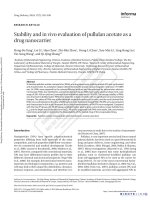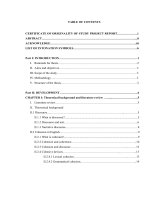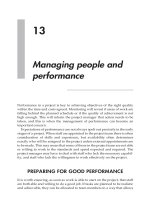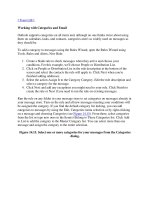Managing people working as individuals and in groups
Bạn đang xem bản rút gọn của tài liệu. Xem và tải ngay bản đầy đủ của tài liệu tại đây (115.33 KB, 15 trang )
©Ian Sommerville 2004 Software Engineering, 7th edition. Chapter 25 Slide 1
Managing people
Managing people working as
individuals and in groups
©Ian Sommerville 2004 Software Engineering, 7th edition. Chapter 25 Slide 2
Objectives
To explain some of the issues involved in selecting
and retaining staff
To describe factors that influence individual
motivation
To discuss key issues of team working including
composition, cohesiveness and communications
To introduce the people capability maturity model
(P-CMM) - a framework for enhancing the
capabilities of people in an organisation
©Ian Sommerville 2004 Software Engineering, 7th edition. Chapter 25 Slide 3
Topics covered
Selecting staff
Motivating people
Managing groups
The people capability maturity model
©Ian Sommerville 2004 Software Engineering, 7th edition. Chapter 25 Slide 4
People in the process
People are an organisation’s most important
assets.
The tasks of a manager are essentially
people-oriented. Unless there is some
understanding of people, management will
be unsuccessful.
Poor people management is an important
contributor to project failure.
©Ian Sommerville 2004 Software Engineering, 7th edition. Chapter 25 Slide 5
People management factors
Consistency
• Team members should all be treated in a comparable way
without favourites or discrimination.
Respect
• Different team members have different skills and these
differences should be respected.
Inclusion
• Involve all team members and make sure that people’s
views are considered.
Honesty
• You should always be honest about what is going well
and what is going badly in a project.
©Ian Sommerville 2004 Software Engineering, 7th edition. Chapter 25 Slide 6
Selecting staff
An important project management task is
team selection.
Information on selection comes from:
• Information provided by the candidates.
• Information gained by interviewing and talking
with candidates.
• Recommendations and comments from other
people who know or who have worked with the
candidates.
©Ian Sommerville 2004 Software Engineering, 7th edition. Chapter 25 Slide 7
Staff selection case study 1
Alice is a software project manager working in a company that develops alarm
systems. This company wishes to enter the growing market of assistive technology to
help elderly and disabled people live independently. Alice has been asked to lead a
team of 6 d evelopers than can develop new products based around the companyÕs
alarm technology. Her first role is to select team members either from software
engineers already in the company or from outside.
To help select a team, Alice first assesses the skills that she will need: These are:
1. Experience with existing alarm technology as it is reused
2. User interface design experience because the users are untrained and may be
disabled and hence need facilities such as variable font sizes, etc.
3. Ideally, someone who has experience of designing assistive technology systems.
Otherwise, someone with experience of interfacing to hardware units as all
systems being developed involve some hardware control.
General purpose development skills.
©Ian Sommerville 2004 Software Engineering, 7th edition. Chapter 25 Slide 8
Staff selection case study 2
The next stage is to try and find peop le from within the company with
the necessary skills. However, the company has expanded significantly
and has few staff available. The best that Alice can negotiate is to have
help from an alarm expert (Fred) for 2 days/week. She therefore
decides to advertise for new project staff, listing the attributes that
sheÕdlike:
1. Programming experience in C. She has decided to develop all the
assistive technology control software in C.
2. Experience in user interface design. A UI designer is essential but
there may not be a needfo r a full-time appointment.
3. Experience in hardware interfacing with C and using remote
development systems. All the devices used have co mplex hardware
interfaces.
4. Experience of working with hardware engineers. At times, it will be
necessary to build completely new hardware.
A sympathetic personality so that they can relate to and work with elderly people who are
providing requirements for and are testing the system.
©Ian Sommerville 2004 Software Engineering, 7th edition. Chapter 25 Slide 9
Lessons
Managers in a company may not wish to
lose people to a new project. Part-time
involvement may be inevitable.
Skills such as UI design and hardware
interfacing are in short supply.
Recent graduates may not have specific
skills but may be a way of introducing new
skills.
Technical proficiency may be less important
than social skills.
©Ian Sommerville 2004 Software Engineering, 7th edition. Chapter 25 Slide 10
Staff selection factors 1
Application domain experienceFor a project to develop a su ccessful system, the
developers must understand the application domain. It is
essential that some members of a development team have
some domain experience.
Platform experience This may be significant if low-level programming is
involved. Otherwise, not usually a critical attribute.
Programming
language experience
This is normally only significant for short duration projects
where there is not enough time to learn a new language.
While learning a language itself is not difficult, it takes
several months to become proficient in using the associated
libraries and components.
Problem solving ability This is very important for software engineers who
constantly have to solve technical problems. However, it is
almost impossible to judge without knowing the work of
the potential team member.
©Ian Sommerville 2004 Software Engineering, 7th edition. Chapter 25 Slide 11
Staff selection factors 2
Educational
background
This may provide an indicator of the basic fundamentals that the
candidate should know and of their ability to learn. This factor
becomes increasingly irrelevant as engineers gain experience
across a range of projects.
Communication
ability
This is important because of the need for project staff to
communicate orally and in writing with other engineers, managers
and customers.
Adaptability Adaptability may be judged by looking at the different types of
experience that candidates have had. This is an important attribute
as it indicates an ability to learn.
Attitude Project staff should have a p ositive attitude to their work and
should be willing to learn new skills. This is an important attribute
but often very difficult to assess.
Personality This is an important attribute but difficult to assess. Candidates
must be reasonably compatible with other team members. No
particular type of personality is more or less suited to software
engineering.
©Ian Sommerville 2004 Software Engineering, 7th edition. Chapter 25 Slide 12
Motivating people
An important role of a manager is to motivate
the people working on a project.
Motivation is a complex issue but it appears
that their are different types of motivation
based on:
• Basic needs (e.g. food, sleep, etc.);
• Personal needs (e.g. respect, self-esteem);
• Social needs (e.g. to be accepted as part of a
group).
©Ian Sommerville 2004 Software Engineering, 7th edition. Chapter 25 Slide 13
Human needs hierarchy
Physiological needs
Safety needs
Social needs
Esteem needs
Self-
realisa tion needs
©Ian Sommerville 2004 Software Engineering, 7th edition. Chapter 25 Slide 14
Need satisfaction
Social
• Provide communal facilities;
• Allow informal communications.
Esteem
• Recognition of achievements;
• Appropriate rewards.
Self-realization
• Training - people want to learn more;
• Responsibility.
©Ian Sommerville 2004 Software Engineering, 7th edition. Chapter 25 Slide 15
Individual motivation
AliceÕs assistive technology project starts well. Good working
relationships develop within the team and creative new ideas are
developed. However, some months into the project, Alice notices that
Dorothy, the hardware design expert starts coming into work late, the
quality of her work deteriorates and, increasingly, she does no t appear to
be communicating with other members of the team. Alice talks about the
problem with other team members to try to find out if DorothyÕs personal
circumstances have changed and if this might be affecting her work. They
donÕtknow of anything so Alice decides to talk with Dorothy to try to
understand the problem.
After denying that there is a problem, Dorothy admits that she seems to
have lost interest in the job. She expec ted a job where she would develop
and use her hardware interfacing skills. However, she is basically working
as a C programmer with other team members and she is concerned that she
is not developing her interfacing skills. She is worried that she will find it
difficult to find a job after this project that involves hardware interfacing.
Because she does not want to upset the team by revealing that she is
thinking abou t the next project, she has decided that it is best to minimise
conve rsation with them.
©Ian Sommerville 2004 Software Engineering, 7th edition. Chapter 25 Slide 16
Personality types
The needs hierarchy is almost certainly an
over-simplification of motivation in practice.
Motivation should also take into account
different personality types:
• Task-oriented;
• Self-oriented;
• Interaction-oriented.
©Ian Sommerville 2004 Software Engineering, 7th edition. Chapter 25 Slide 17
Personality types
Task-oriented.
• The motivation for doing the work is the work itself;
Self-oriented.
• The work is a means to an end which is the achievement
of individual goals - e.g. to get rich, to play tennis, to travel
etc.;
Interaction-oriented
• The principal motivation is the presence and actions of
co-workers. People go to work because they like to go to
work.
©Ian Sommerville 2004 Software Engineering, 7th edition. Chapter 25 Slide 18
Motivation balance
Individual motivations are made up of elements
of each class.
The balance can change depending on personal
circumstances and external events.
However, people are not just motivated by personal
factors but also by being part of a group and culture.
People go to work because they are motivated by
the people that they work with.









